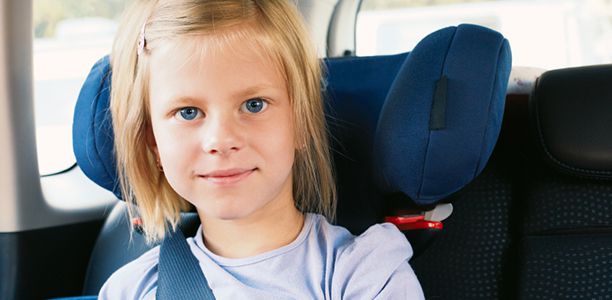Using a safe car seat is not just a responsible thing for parents and other adults to do when they travel in a car with children, it has many safety benefits and is a legal requirement in all Australian states and territories. There are also laws outlining standards for the design and sale of car seats, to ensure that they are safe and will protect children in the event of an accident.
Laws governing the manufacture and sale of car seats
The Mandatory Standard for Child Restraints for Motor Vehicles is a national standard that applies throughout Australia. It specifies how car seats used in Australia should be manufactured. It is regularly updated, with the most recent standard in effect since September 2014. Companies that manufacture, sell or hire car restraints must comply with the specifications in the standard or face legal penalties. All car seats sold in Australia must comply with this standard (Australian Standard AS 1754) and will be labelled with a sticker showing that they are compliant.
Installation instructions
Whenever a car seat is sold, it must come with instructions that show how to install the seat correctly in the car. They are typically attached to the car seat or built into a pocket in the device. Warnings about proper use of the car seat, for example to install it properly and supervise children at all times while they are in the seat, must be printed clearly on the restraint.
Components of car seats
Different types of car seats have different components. For example, car seats for babies and younger children have built-in harnesses and buckles, while others are used with the car’s normal lap-sash belt.
Each component of a car seat must be durable so that it does not wear out and break. Due to structural wear and tear, it is recommended that car seats should not be used if they are more than 10 years old. There must be no sharp or rigid components that might injure a child. The material used to cover a car restraint must be non-toxic.
Anchoring devices are the components of car seats which attach them to the car structure. The car seat must come with instructions showing how to attach the anchor. When installing the car seat, it may also be necessary to refer to the vehicle user manual, to determine where the seat should be anchored in the car.
Built-in car seat harnesses (belts), the components which restrain the child in the seat, must have at least a five-point design. They are found on car seats for young children. This means that they have four separate straps which meet at a central point. Two straps are attached to the top of the car seat and are placed over the child’s shoulders, preventing their torso and head moving forward if the car stops suddenly or is in an accident. The other two straps are attached at the bottom of the harness and are placed between the child’s legs, on either side of their groin.
Harnesses adjusters, which allow the straps to be tightened or loosened, must be easy to use. They should have a single adjuster for all the straps which is self-locking, so that the straps cannot slip loose while the child is restrained. The buckle on built-in harnesses must have a quick release device so that the straps can be unfastened and the child easily released in an emergency.
Testing car seats
All car seats must be tested to see how they perform in an accident. Tests are performed with a dummy in the restraint, and must be simulated for front-end, rear-end, side-impact and roll-over accidents. The child restraint evaluation program (CREP) tests and scores different child restraints based on their safety to help parents choose the safest option for their child. It is endorsed by several state governments. The scores from the tests performed by CREP are published online, and car seats are given a purple star rating out of five to make it easier to choose a car seat based on safety.
Car seat size
New car seats have markings showing the upper and lower limits for where a child’s shoulders should rest when they are seated. Older car seats, complying with previous Australian Standards, may not have these. Children whose shoulders fall below the lower limit need a smaller seat, whereas children whose shoulders rest above the upper limit require a larger seat.
Laws governing the use of seat belts while driving with children
Heavy fines and penalties are given to drivers with children in the car who are not properly restrained. They apply in all Australian states and territories.
Fines and penalties for drivers
Fines up to $500 and a loss of three demerit points apply in all Australian states and territories. In Queensland, the number of demerit points lost may double for drivers who are fined for a child restraint offence twice in a 12 month period.
Legal requirements for properly restraining a child
Being properly restrained means more than just ensuring a child is in a car seat. The seat must be appropriate for their age and size, properly installed in the right position in the car, and the child must be restrained correctly in the seat.
Age appropriate car seat
The type of car seat a child sits in must be appropriate for their age and size. Babies younger than six months of age should travel in a rear facing restraint. Children older than six months should continue to travel in a rear facing restraint until they outgrow it, at which point their shoulders will reach the maximum height marker on the seat. Thereafter, they should travel in a forward facing restraint with a built-in harness. Children aged 4-7 years old must use either a forward facing restraint with built-in harness or a booster seat every time they travel in a car. Although this may seem like a long time, children in the UK have to remain in a child car seat until their twelfth birthday or until they are 135 cm tall. It is strongly recommended that children who are 7 or older continue using a booster seat until they’re 145 cm tall.
Children who are large for their age should progress to the next type of seat when they have outgrown the one they use, while those who are small for their age should continue to use their seat until they outgrow it. For example, a child who is four years old but is not big enough for a booster seat should stay in a forward-facing restraint with built-in harness, and a large three year old might start using a booster seat a bit before their fourth birthday.

Proper position
“Positioned properly” generally means in the back seat rather than the front seat. It is recommended that children up to and including 12 years of age should sit in the back row of seats. However, there are a few exceptions when it is legal to travel with a child restrained in a car seat in the front seat of the car.
It is illegal to put an infant restraint or a forward-facing restraint with harness in the front seat, if your car has more than one row of seats. However, in vehicles with only one row of seats, a baby restraint can go in the front seat as long as there is no airbag. In saying this, rear and forward facing, as well as booster seats, should not be used in a seating position where a front passenger airbag is installed. This is because there is the possibility that the child’s head or restraint could be impacted by the deploying of an airbag. In the 1990s, airbags caused around 50 infant deaths in the USA when rear facing restraints were installed in the front seat and an airbag was deployed.
Children who are older than four are allowed to sit in the front seat of the car in a booster seat if the vehicle has only one row of seats, or if all the back seats are occupied by younger children. In this case, the front seat should be moved as far back as it can go.
Correctly fastened
The child restraint must also be correctly fastened. That is, the harness (if it has a built-in one) or car lap-sash belt (for restraints for older children) must be worn and buckled correctly. The straps of a built-in harness should not be twisted and they should be adjusted so that they hold the child securely in the car seat. The buckle must be fastened. Lap-sash belts used with booster seats must be worn over the shoulder, not tucked under the arm.
References
- Queensland Government. Child restraints [online]. 2015 (cited 30 July 2015). Available from: URL Link
- New South Wales Government. Child car seats [online]. 2015 (cited 30 July 2015). Available from: URL Link
- Tasmanian Government. Child restraints: A guide to car seats [online]. 2015 (cited 30 July 2015). Available from: URL Link
- Vic Roads. Child restraints [online]. 2015 (cited 30 July 2015). Available from: URL Link
- Government of Western Australia. Child car restraints [online]. 2015 (cited 10 August 2015). Available from: URL Link
- Northern Territory Government. Child restraints [online]. 2016 (cited 25 May 2017). Available from: URL Link
- Australian Capital Territory Government. Child restraints in vehicles [online]. 2017 (cited 25 May 2017). Available from: URL Link
- Government of South Australia. Road rules: Seat belts and child restraints [online]. 2015 (cited 10 August 2015). Available from: URL Link
- Product Safety Australia. Child car restraints for use in motor vehicles [online]. 2017 (cited 25 May 2017). Available from: URL Link
- Australian Government. Safety standard: Child restraint systems for use in motor vehicles [online]. 2014 (cited 30 July 2015). Available from: URL Link
- Neuroscience Research Australian and Kidsafe. Best practice guideline for the safe restraint of children travelling in motor vehicles. 2013 (cited 13 August 2015). Available from: URL Link
- Vic Roads. Child restraint evaluation program [online]. 2015 (cited 30 July 2015). Available from: URL Link
- NSW Transport. Ratings explained [online]. 2015 (cited 13 August 2015). Available from: URL link
- Northern Territory Government. Traffic offences and penalties [online]. 2017 (cited 26 May 2017). Available from: URL Link
- United Kingdom Government. Child car seats: The law [online]. 2017 (cited 22 June 2017). Available from: URL Link











